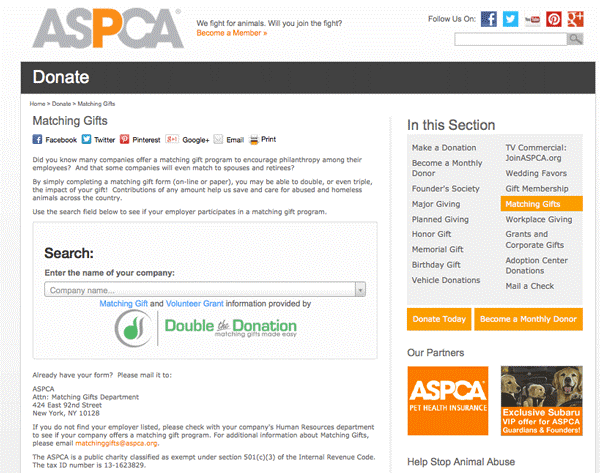Children crave sugar, cars want gasoline, and nonprofits need money to operate at full capacity. While moms bake their children cookies and drivers give their cars all the fuel they need, nonprofits have donors to keep them running. Nonprofits need all the dollars they can get, which is why increasing fundraising from matching gifts is such a crucial endeavor.
What is a matching gift?
You drop your quarters into the slot, tap a couple of buttons, and the machine gives you two candy bars instead of one. Hallelujah! You’re rich! But only in candy.
If you’re a nonprofit then you need funding to provide the crucial services, and, lucky for you, the concept of matching gifts works just like that vending machine:
You get twice the money at no additional cost to your donors.
Where is all the extra money coming from? And can you receive candy bars as a form of donation and have that donation doubled?
We’ll backtrack to the latter question in a bit, but the money comes from corporations. Companies, large and small, North America-based and international, operate charitable giving programs through which they match employee donations to eligible nonprofits. Depending on the company, donations can be doubled, tripled, or even quadrupled.
To demonstrate how matching gifts provide more than pocket change for candy bars, consider Kiki, who is Hershey’s official chocolate taster and the envy of everyone but dogs.
Kiki donates $2,000 to the college where she had the best four years of her life. As an employee of The Hershey Company, the company will match her donation to higher education institutions at a dollar for dollar rate, which means that they write their own $2,000 check to the same nonprofit, thus doubling Kiki’s donation.
$2,000 is not mere pocket change. That’s the kind of financial impact that can open opportunities for your nonprofit, especially if you can secure multiple matched major donations.
Who Offers Matching Gifts?
65% of Fortune 500 companies offer matching gift programs, but corporate giving isn’t just for the big boys. Companies of all sizes, industries, and locations donate through matching gifts. American corporations, Canadian employers, and international companies all offer corporate giving programs.
General Electric started the first corporate matching gift program in 1954, and since then companies of all kinds have embraced corporate philanthropy. Let’s take a look at a few examples:
Microsoft’s Matching Gift Program:
Including matching gifts, Microsoft employees have donated over $1 billion since 1983. Microsoft strives to maximize its corporate giving program in the month of October, when the company hosts over 300 activities, such as 5k’s and auctions, to raise funds for nonprofits, but offers its matching gift program year-round.
Microsoft matches donations between $25 and $15,000 at a 1:1 ratio. Full-time employees, spouses, board members, and part-time employees are eligible to submit requests.
Johnson & Johnson’s Matching Gift Program:
Through Johnson & Johnson’s matching gift program the company matches donations from employees and retirees to most nonprofit organizations.
J&J has a 200% match (meaning the company contributes $2 for every $1 donated) for current employees enabling donations to go extra far. Each employee can have up to $10,000 matched per year for a maximum company contribution of $20,000 annually.
Johnson and Johnson also generously extends its matching gift program to retirees by matching donations at a $1 for $1 rate up to $10,000 annually per retiree.
Verizon’s Matching Gift Program:
Through Verizon’s matching gift program the Verizon Foundation matches donations made by Verizon employees to a wide range of nonprofit organizations. For every dollar an employee donates, the Verizon Foundation matches the gift, dollar for dollar, up to $1,000 each year.
If an employee donates to a college or university the matching gift limit is upped to $5,000 per employee per year.
In the past five years, Verizon employees have contributed over 2.3 million volunteer hours and more than $114 million in donations through employees and matching gifts.
Why Do Companies Offer Matching Gifts?
Yes, matching gifts help nonprofits around the world and of course the leaders of corporations care about the world around them, but companies also receive secondary benefits from offering these programs.
For instance, corporate philanthropy carries the added benefit of positive marketing.
Think about Toms shoes. The Toms brand is synonymous with their one-to-one shoe program that donates a pair of shoes for each pair purchased. Consumers love the idea of performing social good through a routine shoe purchase, and Toms knows this. Yes, Toms is helping millions of shoe-needy people around the world, and truly believes in the social good from offering the program, but the one-for-one shoe program is an effective branding strategy as well.
Matching gifts also build goodwill among employees. Employees submitting matching gift requests is a form of asking employers to support the organizations and causes that employees care about. By offering matching gifts, companies agree to support their employees’ passions and thus build employee loyalty and satisfaction.
What Nonprofits are Eligible for Matching Gifts?
In about two-thirds of year-round matching gift programs companies match donations to a majority of 501(c)(3) organizations, including:
- Educational institutions – Colleges, universities, k-12 schools, educational foundations
- Arts and cultural organizations – Aquariums, libraries, museums, etc.
- Community based social services – Homeless shelters, animal shelters, low-income assistance, etc.
- Environmental organizations – Conservation efforts, wildlife preservation, recycling, etc.
- Healthcare organizations – Hospitals, substance abuse programs, medical research, etc.
In the other third of year-round matching gift programs companies restrict their nonprofit eligibility to nonprofits falling into one or multiple of the above categories.
A few common restrictions include political organizations, sports teams, and religious organizations that lack a focus on community outreach.
How Can You Make the Most of Matching Gifts?
The average employee participation rate for corporate matching gift programs is 9%, and donors are leaving an estimated $6-$10 billion in matching gifts on the table each year. Most donors are not even aware their companies offer matching gift programs.
If you want donors to get the leveraged gifts to which they’re entitled, it’s your job to promote them to your supporters.
Matching gift marketing strategies include:
- Incorporate matching gifts into email newsletters
- Promote matching gifts on social media
- Feature matching gifts in the donation process
- Create a dedicated matching gift page on your website
A dedicated matching gift page is a place to both educate donors about matching gifts and provide a means for donors to discover if their employers offer matching gift programs.
Here is a dedicated matching gift page from the American Society for the Prevention of Cruelty to Animals (ASPCA):
The ASPCA defines a matching gift and then offers a widget for donors to easily search to find out if their companies have corporate giving programs. A good matching gift page should incorporate some combination of the following:
- State how matching gifts benefit your organization
- List companies that have given your nonprofit matching gifts
- Share matching gift statistics
- Provide your nonprofit’s contact information
- Teach donors how to submit matching gift requests
Marketing matching gifts can be inexpensive, and many strategies can be implemented in 30 minutes or less.
For instance, here is a matching gift tweet that the Hereditary Neuropathy Foundation sent out:
The link takes donors to HNF’s dedicated matching gift page.
Are Matching Gifts Only for Donations of Certain Sizes?
Donations, both big and small, can be matched, and the little gifts add up.
Most companies have varying minimum and maximum donation amounts that can be found through looking at each company’s guidelines. Also, donors have long-term value and might increase their gifts over time, and, when they do, you’ll want a matching gift from that larger donation.
If you want to target your major donors, in order bring in doubled donations from your largest gifts, then consider incorporating prospect research into your fundraising strategy.
Prospect research strives to identify major gift donors from long donor lists. If you’re interested in receiving more large donations, and the benefits of matching gifts from those significant gifts, then use prospect research to discover new major gift prospects with greater efficiency. You’ll have more time and resources to dedicate to the other steps in the fundraising process, and you should see an increase in revenue.
It would be great if your mom could bake you up some fresh ‘dough’ or if you could stop by the money pump and simply fill your piggy bank with cash. Unfortunately, the world is not so ideal, and your nonprofit needs to fight for every dollar it can get. Matching gifts are an easy way to increase fundraising, so start promoting corporate giving today and rejoice when you receive two donations instead of one.
The preceding is a guest post by Adam Wenger, President of Double the Donation, the leading provider of matching gift tools and service to nonprofits. Connect with Adam on LinkedIn, Twitter, or join the matching gift discussion.
Photo courtesy of Freedigitalpotos.net







